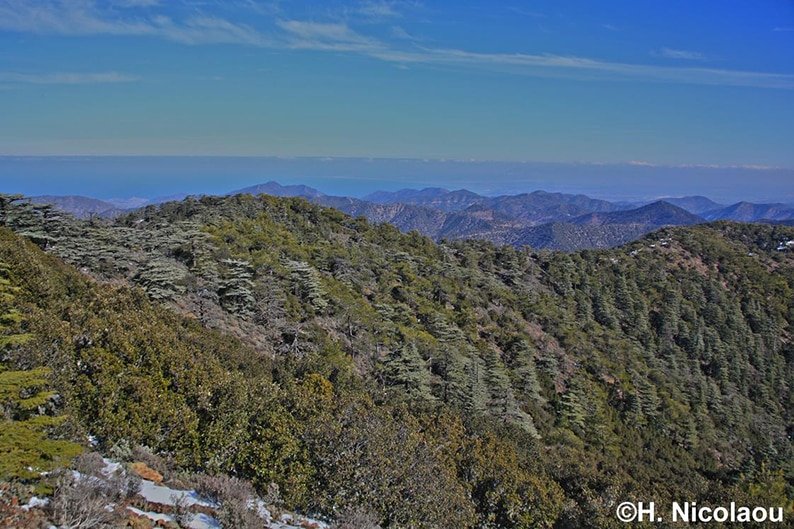
One of the most difficult years ever in terms of wildfires is starting this month, and so it is a good time to recall just how much needs to be done to protect and conserve a forested area.
The abundant rain islandwide over the winter months has produced an abundance of weeds which are already fast turning into dry biomass – in other words, great fuel for fires.
“Why don’t they plant some new trees?” is the usual refrain when people look at a forested area that has been devastated by fire.
But it is not that simple, as one project to conserve just one small area, the Cedar Valley, shows.
The Cedrus bevifolia or Cyprus Cedar is endemic to a very small area of the Troodos mountains.
Conserving it is not all about planting trees, although this is one big part of the ‘Kedros’ project, which started on September 1, 2016, and will be completed on August 31, 2020.
In fact, 9,200 seedlings will be planted in total, 5,000 of which have already been put into the soil, and the rest will be planted by spring 2020, chief conservator of forests at the environment ministry Andreas Christou said.
To add to this, 15 kilos of seeds have been sowed in different parts of the Cedar Valley to strengthen the existing flora.
But the main problem with planting is the constant supply of water the young seedlings need over the year.
Just 100 to 150 of the small trees have been planted in a Waterboxx, a system the government started testing in 2016. Water in the ‘boxes’ is collected from the atmosphere and is gradually fed to the young seedling, which ordinarily would have to be manually watered for at least the first two years after it has been planted.
“They are expensive to buy but we don’t need to irrigate them as they get their water from the atmosphere. We have used them in areas which are difficult to irrigate, in remote places where we cannot reach with tankers,” said Christou, who is also the project coordinator.
“We have been pit planting for hundreds of years, it is a standard method,” he said on other methods. “The disadvantage is that irrigation is costly. We have to irrigate the seedlings every one or two weeks.”
He explained the results of all the planting and the differences of planting using different methods will not be visible to the naked eye any time soon. “This is a very slow growing species. When we plant a 30-centimetre tree it will grow just 10cm in the next five years. After that, they grow much faster, 10 to 20 centimetres annually.”
So much for the tree planting. The project has other different parts, some of which have been completed, others which are in process, and some – very few – which are yet to be implemented.
During a preparatory action, which started in December 2016 and was completed in February 2018, sampling plots were established, but a fire protection plan was also prepared.
A seed sampling analysis was done, for which cameras were installed.
Insect traps were established to monitor which insects frequent the area, especially for the evaluation of bark beetles which tend to attack cedar trees.
Conservation actions go hand-in-hand with the preparatory ones.
Apart from planting and sowing, these include the installation of six fire alarm systems, done in 2017. A number of forest roads have been permanently closed to increase the habitat’s total area.
Controlled grazing was introduced in some areas to reduce biomass and thereby the risk of fire. This is in process and one of the areas where concrete results have been achieved. It has been calculated and documented that the grazing livestock for the period from May to September can be 1070 goats that do not receive food supplements.
Dry weed is also being removed along the main roads, and a new firewall has been constructed while two 90-tonne water tanks have been installed.
Anti-erosion measures include the erection of stone walls and gabions, containers filled with earth or stone.
In parallel, a well-planned collection of trees is carried out, which are stored in a seed bank.
The project also needs measures to improve the resilience of the habitat, all of which have been completed. 10 artificial nests for barn owls have been created, and 20 bat boxes. The installation of insect traps is expected to help fight pests, especially the bark beetles.
Last but not least, the forestry department is working hard to raise public awareness on the targeted habitat and dissemination of the results through rural workshops, production of a project film, printing materials and the creation of a website.
The total project budget is €1.413.304, of which €968.330, 68.6 per cent of its total eligible budget are co-funded by the EU. The project works towards the sustainable conservation management and protection of the Cedar trees both within its natural range in the valley and in the wider area.
More info can be found here http://www.life-kedros.eu
The post Reforesting Cedar Valley is a painstaking process appeared first on Cyprus Mail.
Read more → https://cyprus-mail.com/2019/05/05/reforesting-cedar-valley-is-a-painstaking-process/



Δεν υπάρχουν σχόλια:
Δημοσίευση σχολίου